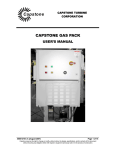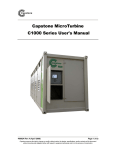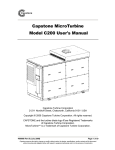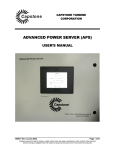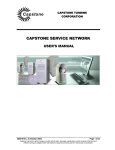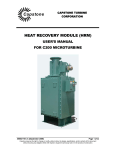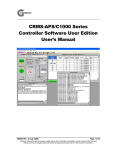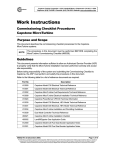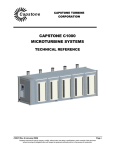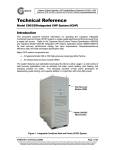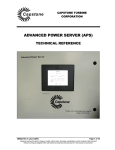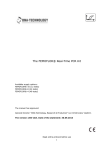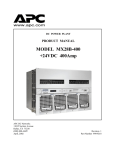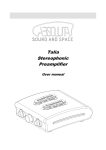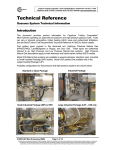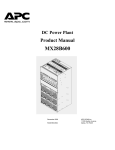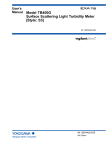Download Capstone Products
Transcript
Capstone CAPSTONE TURBINE CORPORATION DUAL MODE SYSTEM CONTROLLER (DMSC) USER’S MANUAL 400023 Rev A (October 2008) Page 1 of 27 Capstone reserves the right to change or modify, without notice, the design, specifications, and/or contents of this document without incurring any obligation either with respect to equipment previously sold or in the process of construction. Capstone Turbine Corporation • 21211 Nordhoff Street • Chatsworth • CA 91311 • USA Dual Mode System Controller (DMSC): User’s Manual Copyright © 2008 Capstone Turbine Corporation. All Rights Reserved. Publisher Capstone Turbine Corporation 21211 Nordhoff Street Chatsworth • CA 91311 • USA Telephone: (818) 734-5300 Facsimile: (818) 734-5320 Website: www.microturbine.com 400023 Rev A (October 2008) Page 2 of 27 Capstone reserves the right to change or modify, without notice, the design, specifications, and/or contents of this document without incurring any obligation either with respect to equipment previously sold or in the process of construction. Capstone Turbine Corporation • 21211 Nordhoff Street • Chatsworth • CA 91311 • USA Dual Mode System Controller (DMSC): User’s Manual TABLE OF CONTENTS About This Document......................................................................................................................5 Safety Precautions.......................................................................................................................5 Symbols........................................................................................................................................5 General Precautions ....................................................................................................................7 Electrical Precautions ..................................................................................................................8 Product Overview ............................................................................................................................9 Introduction...................................................................................................................................9 DMSC Block Diagram............................................................................................................... 10 Safety Interlocks........................................................................................................................ 11 Considerations for Circuit Breaker Isolation Devices............................................................... 12 Product Interface Definition .......................................................................................................... 12 User Controls and Indicator Lamps.......................................................................................... 13 POWER Switch ..................................................................................................................... 14 MODE Switch ........................................................................................................................ 14 MICROTURBINE AWAKE Indicator Lamp .......................................................................... 15 LOAD POWER OK Indicator Lamp...................................................................................... 15 LINE POWER OK Indicator Lamp........................................................................................ 15 DMC Annunciator Panel ........................................................................................................... 15 Key Switch ............................................................................................................................. 16 Indicator Lamps ..................................................................................................................... 16 Product Operation ........................................................................................................................ 17 DMSC Operational Modes ....................................................................................................... 17 Grid Connect Operation Settings.......................................................................................... 17 Stand Alone (Standby) Operation Settings .......................................................................... 17 Dual Mode (Grid Connect/Stand Alone) Operation Settings ............................................... 18 Disconnect Device Logic .......................................................................................................... 18 Conditions to Close the Disconnect Device ......................................................................... 18 Conditions to Open the Disconnect Device.......................................................................... 19 Control Power Transformer Configuration ............................................................................... 19 Undervoltage Relay Settings.................................................................................................... 19 Fixed Settings........................................................................................................................ 21 Adjustable Settings................................................................................................................ 21 UVR LED Status Indications................................................................................................. 22 Timer Relay Settings................................................................................................................. 23 400023 Rev A (October 2008) Page 3 of 27 Capstone reserves the right to change or modify, without notice, the design, specifications, and/or contents of this document without incurring any obligation either with respect to equipment previously sold or in the process of construction. Capstone Turbine Corporation • 21211 Nordhoff Street • Chatsworth • CA 91311 • USA Dual Mode System Controller (DMSC): User’s Manual MicroTurbine Software Settings ............................................................................................... 23 Power Connect...................................................................................................................... 24 Auto Restart........................................................................................................................... 24 Grid Reconnect Delay ........................................................................................................... 24 Grid Reconnect Toggle ......................................................................................................... 24 Stand Alone (SA) Load Wait................................................................................................. 24 SA Fast Transfer Delay......................................................................................................... 24 Auto Enable Power................................................................................................................ 24 Start Input .............................................................................................................................. 24 UCB Output Relay Settings .................................................................................................. 25 Product Maintenance ................................................................................................................... 26 Product Specifications.................................................................................................................. 26 Reference Documentation ........................................................................................................... 26 Capstone Contact Information ..................................................................................................... 27 List of Figures Figure 1. Annunciator Panel................................................................................................. 9 Figure 2. DMSC Block Diagram ......................................................................................... 10 Figure 3. DMSC Front Panel User Controls and Indicators ............................................... 13 Figure 4. DMC Annunciator Front Panel ............................................................................ 16 Figure 5. DMSC Undervoltage Relay................................................................................. 20 Figure 6. Timer Relay......................................................................................................... 23 List of Tables Table 1. POWER Switch Settings ...................................................................................... 14 Table 2. MODE Switch Settings......................................................................................... 15 Table 3. Grid Connect Operation Settings ......................................................................... 17 Table 4. Stand Alone (Standby) Operation Settings .......................................................... 17 Table 5. Dual Mode Operation Settings ............................................................................. 18 Table 6. Undervoltage Relay Adjustable Settings.............................................................. 21 Table 7. LED Status Indications......................................................................................... 22 Table 8. UCB Output Relay Parameters ............................................................................ 25 Table 9. Reference Documents ......................................................................................... 26 400023 Rev A (October 2008) Page 4 of 27 Capstone reserves the right to change or modify, without notice, the design, specifications, and/or contents of this document without incurring any obligation either with respect to equipment previously sold or in the process of construction. Capstone Turbine Corporation • 21211 Nordhoff Street • Chatsworth • CA 91311 • USA Dual Mode System Controller (DMSC): User’s Manual ABOUT THIS DOCUMENT This document provides user instructions to operate and maintain the Capstone Turbine Corporation Dual Mode System Controller, hereafter referred to as the DMSC. This document is intended for user personnel who may not have specific training on the DMSC. Capstone Authorized Service Providers (ASPs) have received rigorous training and have been certified to perform commissioning, troubleshooting, and repair of the DMSC and other Capstone products. User personnel who have not received satisfactory training on DMSC should not attempt any procedures other than those specifically described in this document. Symbols There are three very important symbols used in this document: Warnings, Cautions, and Notes. WARNINGs and CAUTIONs alert you to situations and procedures that can be dangerous to people and/or cause equipment damage. NOTEs provide additional information relating to a specific operation or task. WARNING A Warning means that personal injury or death is possible. CAUTION A Caution means that damage to the equipment is possible. NOTE A Note is used to clarify instructions or highlight information that might be overlooked. 400023 Rev A (October 2008) Page 5 of 27 Capstone reserves the right to change or modify, without notice, the design, specifications, and/or contents of this document without incurring any obligation either with respect to equipment previously sold or in the process of construction. Capstone Turbine Corporation • 21211 Nordhoff Street • Chatsworth • CA 91311 • USA Dual Mode System Controller (DMSC): User’s Manual Safety Precautions WARNING Do not work on the MicroTurbine, Dual Mode System Controller, or related equipment if gas odor is detected. Read and understand the Safety Information section of the Capstone MicroTurbine™ Model C65 User’s Manual (400017) or C200 User’s Manual (400008) before working on the Capstone MicroTurbine, the DMSC and related equipment. Failure to obey all safety precautions and general instructions may cause personal injury and/or damage to the equipment. Only Capstone ASPs should open the MicroTurbine enclosure or the DMSC enclosure due to the inherent danger of multiple power sources. Observe the following Safety Precautions when servicing the DMSC: Command the MicroTurbine system to OFF (if not OFF already). Open and lock the dedicated disconnect switch to de-energize the MicroTurbine from the utility grid, and isolate the MicroTurbine from loads. Isolate and lockout all sources of power to the DMSC and remote disconnect device. Disconnect all incoming fuel sources to the MicroTurbine. If the MicroTurbine is equipped with battery packs (i.e., if the MicroTurbine includes the Stand Alone Option), open the battery isolation switches and unplug the battery cables. Wait at least 5 minutes after disconnection from the utility grid before servicing to allow for electrical energy dissipation. Open the DMSC enclosure and verify that no voltage is present on any electrical terminals. Conduct maintenance operations in a clean and well-lighted area. Handle electronic components using best practice safety guidelines to prevent damage to equipment and preclude injury. Read and adhere to the instructions contained in this document completely, prior to installing or operating the DMSC, or installing or operating MicroTurbine connected to the DMSC. 400023 Rev A (October 2008) Page 6 of 27 Capstone reserves the right to change or modify, without notice, the design, specifications, and/or contents of this document without incurring any obligation either with respect to equipment previously sold or in the process of construction. Capstone Turbine Corporation • 21211 Nordhoff Street • Chatsworth • CA 91311 • USA Dual Mode System Controller (DMSC): User’s Manual General Precautions The following general precautions must be observed and followed at all times. Failure to do so may result in personal injury and/or equipment damage. NOTE Some of the following precautions do not directly apply to users, but it is important for users to be aware of them. • Only Capstone Authorized Service Providers are permitted access to the inside of the enclosure. • Read and understand the User's Manual before operating the equipment. • Read and obey all warnings and cautions. • Make sure all electrical connections are tight, clean, dry, and protected from weather and damage. • The MicroTurbine may be equipped with a heat recovery system. Use caution around relief valves where hot water and steam may be present. • A pressurized MicroTurbine enclosure should not be opened: 1) Unless the area is known to be free of flammable materials; 2) All devices have been de-energized from the utility. Power should not be restored until the enclosure has been purged for three minutes. • Use hearing protection when you work on or near an operating MicroTurbine for extended time periods. • Keep the equipment clean. • Keep all flammable materials away from the DMSC and MicroTurbine. • Do not operate or work on the equipment if mentally or physically impaired, or after consumption of alcohol or drugs. • Make sure all fasteners are installed and properly tightened. • Keep an ABC rated fire extinguisher near the MicroTurbine. • Obey all applicable local, state, and national codes and regulations. 400023 Rev A (October 2008) Page 7 of 27 Capstone reserves the right to change or modify, without notice, the design, specifications, and/or contents of this document without incurring any obligation either with respect to equipment previously sold or in the process of construction. Capstone Turbine Corporation • 21211 Nordhoff Street • Chatsworth • CA 91311 • USA Dual Mode System Controller (DMSC): User’s Manual Electrical Precautions WARNING The DMSC contains and produces high voltage. High voltage can injure or kill. Obey all safety procedures when you work around electrical equipment. WARNING Make sure the system is off and the dedicated disconnect switch is in the open position and is locked. This will help prevent injury and damage to the equipment. NOTE Some of the following precautions do not directly apply to users, but it is important for users to be aware of them. The output voltage and residual capacitor voltage of this equipment is dangerous. Use caution when you work on electrical equipment. The DMSC can include multiple sources of power. Make sure to turn off the system and lock out all sources of power prior to doing any work on the equipment. 400023 Rev A (October 2008) Page 8 of 27 Capstone reserves the right to change or modify, without notice, the design, specifications, and/or contents of this document without incurring any obligation either with respect to equipment previously sold or in the process of construction. Capstone Turbine Corporation • 21211 Nordhoff Street • Chatsworth • CA 91311 • USA Dual Mode System Controller (DMSC): User’s Manual PRODUCT OVERVIEW Introduction The DMSC interfaces with Capstone MicroTurbines and the optional Advanced Power Server, hereafter referred to as APS, to allow MicroTurbines to operate in Grid Connect mode and transition MicroTurbine output power to protected loads during an electric utility outage. The DMSC operates in the voltage range of 400 to 500 VAC. The effective current rating depends on the selected remote disconnect device and on the number of configured MicroTurbines in the system. An optional Annunciator Panel (see Figure 1), when connected to the DMSC, displays the MicroTurbine status and mode of operation, and can shut down the MicroTurbine(s) when an emergency situation occurs. Figure 1. Annunciator Panel 400023 Rev A (October 2008) Page 9 of 27 Capstone reserves the right to change or modify, without notice, the design, specifications, and/or contents of this document without incurring any obligation either with respect to equipment previously sold or in the process of construction. Capstone Turbine Corporation • 21211 Nordhoff Street • Chatsworth • CA 91311 • USA Dual Mode System Controller (DMSC): User’s Manual DMSC Block Diagram Refer to Figure 2 for a block diagram of the DMSC. An optional Capstone Protective Relay, hereafter referred to as CPR, when connected to the DMSC, can provide an external trip signal for the remote disconnect device. An optional Capstone APS can be used to interface with the DMSC. In this configuration, the DMSC allows the APS to control one or more MicroTurbines. The APS enables each MicroTurbine to operate in Grid Connect mode and transition its output power to protected loads during an electric utility outage. Capstone Protective Relay (Optional) Advanced Power Server (Optional)* DMSC Capstone Multipac Cables MT1 (Master)* (Path without APS) MT2 (Sub) Disconnect Device MT3 (Sub) MT4 (Sub) DMC Annunciator Panel (Optional) GRID Protected Load * If Advanced Power Server (APS) is used, the APS will be Master and all connected MTs will be Subordinates. Power Wire Control Cable Figure 2. DMSC Block Diagram 400023 Rev A (October 2008) Page 10 of 27 Capstone reserves the right to change or modify, without notice, the design, specifications, and/or contents of this document without incurring any obligation either with respect to equipment previously sold or in the process of construction. Capstone Turbine Corporation • 21211 Nordhoff Street • Chatsworth • CA 91311 • USA Dual Mode System Controller (DMSC): User’s Manual Safety Interlocks In a Dual Mode installation, the MicroTurbine has a set of safety interlocks designed to prevent the unit from operating in Stand Alone when connected to the utility. These interlocks interface with an auxiliary contact of the remote disconnect device to isolate the MicroTurbine from the utility (see Figure 2). Utility companies are concerned that utility worker safety may be compromised if they come in contact with a de-energized line section that becomes energized by a distributed or standby generator. When operating in Grid Connect mode, the MicroTurbine contains protective relay functions to ensure that the unit does not energize the utility lines unless the frequency and voltages on each phase are within operating limits defined in the interconnection agreement with the utility. These protective functions are designed to prevent a MicroTurbine operating in Grid Connect mode from energizing a line that has been de-energized by the utility. When operating in Stand Alone mode, the MicroTurbine is designed to be the sole source of power in the local power system comprising MicroTurbines and the protected loads. In this mode, a MicroTurbine is capable of energizing a de-energized power system. Therefore, it is important that the MicroTurbine is always operating in Grid Connect mode when running in parallel with the utility and should only be operated in the Stand Alone when it is isolated from the utility. The DMSC provides a second level of interlock that operates independently from an auxiliary contact-based interlock. In this interlock level, a solid-state relay in the User Connection Bay (UCB) of a MicroTurbine is programmed to close when a MicroTurbine enters the Stand Alone Load state. When the relay closes, it immediately energizes the shunt trip of a remote motoroperated disconnect device and removes power to the motor operator, keeping the disconnect device in the open state. In a MultiPac system, the interlocks are only required on the master MicroTurbine. The master communicates the status of the interlocks and the operating mode to the subordinate MicroTurbines. If communication fails to a subordinate unit, the subordinate will shut down. 400023 Rev A (October 2008) Page 11 of 27 Capstone reserves the right to change or modify, without notice, the design, specifications, and/or contents of this document without incurring any obligation either with respect to equipment previously sold or in the process of construction. Capstone Turbine Corporation • 21211 Nordhoff Street • Chatsworth • CA 91311 • USA Dual Mode System Controller (DMSC): User’s Manual Considerations for Circuit Breaker Isolation Devices The DMSC opens the remote disconnect device by energizing the shunt trip on the disconnect device, which moves it to the TRIP position. The TRIP position is the normal state for Stand Alone mode operation. Once the utility voltages return to the normal range, the DMSC de-energizes the shunt trip and transitions the remote disconnect device from the TRIP position, via the OFF position, to the ON position. This recloses the remote disconnect device from the TRIP position. If the remote disconnect device is a circuit breaker, it contains an over-current trip unit that operates in the case of an over-current condition. An over-current condition will occur if there is a low impedance fault in the Protected Load or MicroTurbine circuits. The over-current mechanism operates by transitioning the circuit breaker to the TRIP position. Typically, once a circuit-breaker is in the TRIP position it gives no direct indication of whether the trip was caused by the shunt-trip or by the over-current trip. The DMSC is designed to automatically reclose the remote disconnect device from the TRIP position when the utility voltage is in the acceptable range. This is the correct and desirable behavior when the disconnect device was tripped by the DMSC logic via the shunt trip. However, it is not desirable to reclose the disconnect device if it was tripped by the over-current unit. In this case, there may be a persistent fault in the circuits served by the disconnect device. The reclosure of the disconnect device will cause the fault to be re-energized. This may increase the hazard associated with the fault and is likely to result in a cyclic tripping/reclosing of the disconnect device. This is stressful for the disconnect device and may result in premature failure. The DMSC contains a reclose lock-out circuit using a latching relay to prevent the automatic reclosure of the remote disconnect device unless a shunt-trip action has been performed. In normal operating conditions, this prevents automatic reclosure of the disconnect device after it has been tripped by the over-current unit. The reclose lock-out circuit also prevents automatic reclosure of the disconnect device if it was tripped manually or opened manually. When utility power is restored, the disconnect device will not be closed and the REMOTE TRIP indicator lamp (LP6) will illuminate. If the REMOTE TRIP lamp is illuminated, the DMSC can only close the remote disconnect device after the MANUAL RESET button (S3) has been pressed. A manual close of the remote isolation switch should only be performed if a qualified person has determined that there are no persistent electrical faults in the circuits served by the remote disconnect device. 400023 Rev A (October 2008) Page 12 of 27 Capstone reserves the right to change or modify, without notice, the design, specifications, and/or contents of this document without incurring any obligation either with respect to equipment previously sold or in the process of construction. Capstone Turbine Corporation • 21211 Nordhoff Street • Chatsworth • CA 91311 • USA Dual Mode System Controller (DMSC): User’s Manual PRODUCT INTERFACE DEFINITION User Controls and Indicator Lamps The DMSC has three user controls: POWER ON switch (S1), MODE switch (S2), and MANUAL RESET switch (S3). It also has six indicator lamps: LINE POWER OK (LP1), LOAD POWER OK (LP2), MICROTURBINE AWAKE (LP3), SWITCH CLOSED (LP4), SWITCH OPEN (LP5), and REMOTE TRIP (LP6). Figure 3 shows the front panel user controls and indicator lamps. LINE POWER OK SWITCH CLOSED LINE POWER OK (LP1) SWITCH CLOSED (LP4) LOAD POWER OK SWITCH OPEN LOAD POWER OK (LP2) SWITCH OPEN (LP5) MICROTURBINE AWAKE REMOTE TRIP REMOTE TRIP (LP6) MICROTURBINE AWAKE (LP3) MODE AUTO GRID TURBINE MANUAL RESET MODE Switch (S2) MANUAL RESET (S3) POWER ON OFF BSTART POWER Switch (S1) Figure 3. DMSC Front Panel User Controls and Indicators 400023 Rev A (October 2008) Page 13 of 27 Capstone reserves the right to change or modify, without notice, the design, specifications, and/or contents of this document without incurring any obligation either with respect to equipment previously sold or in the process of construction. Capstone Turbine Corporation • 21211 Nordhoff Street • Chatsworth • CA 91311 • USA Dual Mode System Controller (DMSC): User’s Manual POWER Switch A key is required to operate the power switch. The DMSC may be set to ON or OFF and the key may be removed in either position. The third position is the momentary BSTART position to awaken the battery. Table 1 summarizes the POWER switch position options. Table 1. POWER Switch Settings Power Switch Position Description OFF MicroTurbines are shut down. Protected loads and MicroTurbines are isolated from the utility, if 24 VDC is available from the APS or master MicroTurbine to trip the remote disconnect device as shown in Figure 2. ON The MicroTurbine operating mode and disconnect device status are controlled by the MODE switch and by MicroTurbine operational settings. BSTART When the DMSC is set to BSTART, the MicroTurbine awakens if it is in the battery-saving sleep state. To prevent discharging the battery, the spring-return action quickly returns the switch to the ON position. Turning the switch to BSTART when the MICROTURBINE AWAKE lamp is lit can also drain the battery. To prolong battery life, do NOT use the BSTART position if the MICROTURBINE AWAKE lamp is lit. Only use the BSTART position to awaken the MicroTurbines immediately prior to a Stand Alone start. MODE Switch The MODE switch is a rotary switch that allows operational settings of the MicroTurbines for the Grid Connect Only mode, Automatic Transition mode, or for the Stand Alone Only mode. Table 2 summarizes the MODE switch position options. NOTE Some considerations apply if the mode switch position is changed during MicroTurbine operation. If changed from GRID to TURBINE or from TURBINE to GRID, expect that protected loads will be without power for a period of time as determined by system settings. If changed from AUTO to GRID or TURBINE, protected loads can also be without power for a period of time if the MicroTurbine was in the opposite mode before the change. If changed from GRID or TURBINE to AUTO, the MicroTurbine will remain in whatever mode it was in until the DMSC automatically changes the mode based on the status of the utility grid. 400023 Rev A (October 2008) Page 14 of 27 Capstone reserves the right to change or modify, without notice, the design, specifications, and/or contents of this document without incurring any obligation either with respect to equipment previously sold or in the process of construction. Capstone Turbine Corporation • 21211 Nordhoff Street • Chatsworth • CA 91311 • USA Dual Mode System Controller (DMSC): User’s Manual Table 2. MODE Switch Settings Mode Switch Position Description GRID MicroTurbines may be operated in Grid Connect mode only. During a utility outage, the MicroTurbines shut down and protected loads do not receive power. AUTO The MicroTurbines operate automatically in Grid Connect mode when the utility lines are energized, and in Stand Alone mode during a utility outage. Transition times between modes depend on system settings. TURBINE The MicroTurbines may be operated in Stand Alone only. Power from the MicroTurbines (24 VDC) is used to trip the remote disconnect device and prevent automatic reclosure. MANUAL RESET Switch The MANUAL RESET switch is used to reset the shunt trip of the remote disconnect device after it has been tripped for any reason other than a trip signal from the DMSC. The REMOTE TRIP lamp should extinguish when the MANUAL RESET switch is pressed. LINE POWER OK Indicator Lamp The LINE POWER OK lamp illuminates when the utility voltages are at an acceptable level and of the correct rotational sequence (L1-L2-L3). If the LINE POWER OK lamp does not illuminate when the DMSC is first energized by the utility, check the utility supply for both correct voltage and for correct rotational sequence. LOAD POWER OK Indicator Lamp The LOAD POWER OK lamp illuminates when protected loads are energized by either the utility or the MicroTurbines. MICROTURBINE AWAKE Indicator Lamp The MICROTURBINE AWAKE lamp illuminates when the DMSC is receiving 24 VDC from the MicroTurbine. In a MultiPac system, this lamp illuminates when the master MicroTurbine controls are energized. SWITCH CLOSED Indicator Lamp The SWITCH CLOSED lamp illuminates to indicate that the switch of the remote disconnect device is closed. In the closed position, the protected loads are connected to the utility. SWITCH OPEN Indicator Lamp The SWITCH OPEN lamp illuminates to indicate that the switch on the remote disconnect device is open. In the open position, the protected loads are disconnected from the utility. REMOTE TRIP Indicator Lamp The REMOTE TRIP lamp illuminates when the shunt trip of the remote disconnect device has been tripped by any device other than the DMSC. 400023 Rev A (October 2008) Page 15 of 27 Capstone reserves the right to change or modify, without notice, the design, specifications, and/or contents of this document without incurring any obligation either with respect to equipment previously sold or in the process of construction. Capstone Turbine Corporation • 21211 Nordhoff Street • Chatsworth • CA 91311 • USA Dual Mode System Controller (DMSC): User’s Manual DMC Annunciator Panel The optional DMC Annunciator Panel displays the status of the MicroTurbines and the power availabilities of utility and protective load. Figure 4 shows the front panel layout for the DMC Annunciator Panel. Key Switch Figure 4. DMC Annunciator Front Panel Key Switch The DMC Annunciator Panel has a key switch (Automatic Operation/Emergency Stop) to allow Fire Department authorities to stop the power generation of the MicroTurbines. When the key switch is set to Emergency Stop position, the MicroTurbines will shut down and the remote disconnect device will open. When the key switch is turned to Automatic Operation position, the operation of MicroTurbines will depend on the setting of the DMSC and MicroTurbines. Indicator Lamps The following indicator lamps are activated by signals provided by the DMSC. • Grid Connect (Green Lamp) – illuminated when the MicroTurbine(s) are operating in Grid Connect mode. • Stand Alone (Green Lamp) – illuminated when the MicroTurbine(s) are operating in Stand Alone mode. • Utility Power (Red Lamp) – illuminated when the utility power is available. • Protected Load (Red Lamp) – illuminated when the power is provided to protected load from either the grid or the MicroTurbine. 400023 Rev A (October 2008) Page 16 of 27 Capstone reserves the right to change or modify, without notice, the design, specifications, and/or contents of this document without incurring any obligation either with respect to equipment previously sold or in the process of construction. Capstone Turbine Corporation • 21211 Nordhoff Street • Chatsworth • CA 91311 • USA Dual Mode System Controller (DMSC): User’s Manual PRODUCT OPERATION DMSC Operational Modes Grid Connect Operation Settings Table 3 shows the settings for Grid Connect operation. Table 3. Grid Connect Operation Settings Device / Parameter POWER Switch MODE Switch NOTE Setting Location ON DMSC Front Panel GRID DMSC Front Panel Protected loads are connected to the utility, provided utility power is available to close the remote disconnect device. Stand Alone (Standby) Operation Settings Table 4 shows the settings for Stand Alone operation. Table 4. Stand Alone (Standby) Operation Settings Device / Parameter POWER Switch MODE Switch NOTE Setting Location ON DMSC Front Panel TURBINE DMSC Front Panel Protected loads are isolated from the utility, provided 24 VDC is available from the MicroTurbine(s) to open the remote disconnect device. 400023 Rev A (October 2008) Page 17 of 27 Capstone reserves the right to change or modify, without notice, the design, specifications, and/or contents of this document without incurring any obligation either with respect to equipment previously sold or in the process of construction. Capstone Turbine Corporation • 21211 Nordhoff Street • Chatsworth • CA 91311 • USA Dual Mode System Controller (DMSC): User’s Manual Dual Mode (Grid Connect/Stand Alone) Operation Settings These settings are required to configure the DMSC and MicroTurbines to perform an automatic transition between Grid Connect and Stand Alone modes during a utility outage, and return to the Grid Connect mode as utility voltage is restored. Table 5 shows settings for Dual Mode operation. Table 5. Dual Mode Operation Settings Device / Parameter Setting DMSC POWER Switch DMSC MODE Switch ON DMSC Front Panel AUTO DMSC Front Panel Battery Circuit Breaker on MicroTurbines MicroTurbine Power Connection Location ON MicroTurbine Battery Pack DUAL MODE MicroTurbine Display Panel/CRMS MicroTurbine Auto Restart ON MicroTurbine Display Panel/CRMS MicroTurbine Auto Load ON MicroTurbine Display Panel/CRMS MicroTurbine Start Input (configured as Grid Connect and as a standby generator) GC USER / SA REMOTE MicroTurbine Display Panel/CRMS MicroTurbine Start Input (operating as standby generator only) REMOTE MicroTurbine Display Panel/CRMS DUAL MODE CONTROL, ACTIVE CLOSED MicroTurbine Display Panel/CRMS MicroTurbine UCB Solid State Relay Output (wired to DMSC terminals 9 and 10) Disconnect Device Logic Conditions for disconnect device operation are as follows: Conditions to Close the Disconnect Device • POWER switch (S1) is in the ON or BSTART position • AND the MODE switch (S2) must be in the AUTO or GRID position • AND utility voltage is within the acceptable range of the DMSC’s UVR • AND the MicroTurbine is not in the Stand Alone Load state • AND the Annunciator Panel (if fitted) is set to Automatic Operation • AND the CPR (if fitted) is not tripped • AND the disconnect device was opened by a shunt-trip from the DMSC (not a “Remote Trip”) • AND 24V control power is available from the MicroTurbine, APS or utility powered DMSC power supply. 400023 Rev A (October 2008) Page 18 of 27 Capstone reserves the right to change or modify, without notice, the design, specifications, and/or contents of this document without incurring any obligation either with respect to equipment previously sold or in the process of construction. Capstone Turbine Corporation • 21211 Nordhoff Street • Chatsworth • CA 91311 • USA Dual Mode System Controller (DMSC): User’s Manual Conditions to Open the Disconnect Device • POWER switch (S1) is in the OFF position • OR the MODE switch (S2) is in the TURBINE position • OR the MODE switch (S2) is in AUTO position AND utility voltage is not within the acceptable range of the DMSC’s UVR • OR the MicroTurbine is in the Stand Alone Load state • OR the Annunciator Panel (if fitted) is set to Emergency Stop • OR the CPR (if fitted) is tripped. In all cases, 24 VDC power MUST be available from the MicroTurbine to trip the remote disconnect device. Control Power Configuration The DMSC contains two AC/DC power supplies. The first power supply provides 24 VDC (nominal) for use by the components internal to the DMSC. The second power supply provides 24 VDC (nominal) for use by the optional Annunciator Panel. 400023 Rev A (October 2008) Page 19 of 27 Capstone reserves the right to change or modify, without notice, the design, specifications, and/or contents of this document without incurring any obligation either with respect to equipment previously sold or in the process of construction. Capstone Turbine Corporation • 21211 Nordhoff Street • Chatsworth • CA 91311 • USA Dual Mode System Controller (DMSC): User’s Manual Undervoltage Relay Settings The DMSC contains an Undervoltage Relay (UVR) that determines whether and/or when to isolate the MicroTurbine and protected loads from the utility grid (see Figure 5). The UVR settings can only be changed from inside the DMSC cabinet, and its function is independent of the protective functions within the MicroTurbine. UVR LED Undervoltage Percentage Setting Undervoltage Time Delay Setting Nominal Voltage Setting Unbalance Setting Time Delay Restart Setting Figure 5. DMSC Undervoltage Relay The UVR is a microprocessor-based relay that provides the logic to isolate the MicroTurbine and protected loads from the utility grid in the event of a phase loss, phase reversal, phase unbalance, undervoltage, or overvoltage fault. The UVR is energized when the phase sequence and all voltages are correct. Any one of the five fault conditions will de-energize (“trip”) the UVR. The UVR has dials for user-adjustable settings and a status indicator LED. The UVR is tripped when a phase or voltage parameter rises above or drops below a setpoint for a specific period of time. For an undervoltage fault, the UVR provides a user-adjustable time delay to prevent nuisance tripping caused by momentary voltage fluctuations. The length of time that the UVR takes to power up and restart after a fault is also adjustable by the user. The other response times, or time delays in response to phase or voltage faults, are fixed settings in the UVR. 400023 Rev A (October 2008) Page 20 of 27 Capstone reserves the right to change or modify, without notice, the design, specifications, and/or contents of this document without incurring any obligation either with respect to equipment previously sold or in the process of construction. Capstone Turbine Corporation • 21211 Nordhoff Street • Chatsworth • CA 91311 • USA Dual Mode System Controller (DMSC): User’s Manual Fixed Settings The settings that are fixed, and not adjustable by the user, are described below. • Phase Loss: The UVR trips on the loss of any line voltage phase A, B, or C. • Phase Reversal: The UVR ensures that the DMSC phase sequence is consistent with the utility phase rotation. If incorrect phase rotation wiring is detected, the UVR will trip and grid connect operation is disallowed. The LED status indication for a phase reversal is a steady amber color (refer to Table 6). NOTE The utility, MicroTurbine and protected loads MUST ALL be connected in a consistent phase rotation sequence. Normally, this sequence is L1-L2-L3, counterclockwise. In cases where the utility phase rotation is determined to be other than L1-L2-L3, counterclockwise, the MicroTurbine, disconnect device, UVR, and protected load connections must ALL be re-wired for consistent phase rotation with the utility. • Overvoltage: The overvoltage setpoint is fixed at 110% of the nominal voltage. The UVR trips when the average of all three line phases is greater than this setpoint for a period longer than the time delay dropout. Refer to Response Times below for a description of time delay dropout. • Response Times: The UVR includes the following fixed response times: Phase Loss and Reversal – 100 ms fixed Phase Unbalance – 2 seconds fixed Overvoltage – Fixed time based on an inverse time curve. Adjustable Settings Settings that are adjustable by the user are described in Table 6. Table 6. Undervoltage Relay Adjustable Settings Parameter Undervoltage Settings 80 to 95% of nominal voltage (Suggested setting = 85%) UVR Dial UNDERVOLTAGE The UVR trips when the average of all three lines is less than the adjusted setpoint for a period longer than the adjustable time delay. Nominal Voltage 208, 220, 230, 240, 400, 440, 460, 480 V NOMINAL VOLTAGE This must be set to the actual three-phase voltage before line voltage is applied to the DMSC. DO NOT adjust this setting with line voltage applied. 400023 Rev A (October 2008) Page 21 of 27 Capstone reserves the right to change or modify, without notice, the design, specifications, and/or contents of this document without incurring any obligation either with respect to equipment previously sold or in the process of construction. Capstone Turbine Corporation • 21211 Nordhoff Street • Chatsworth • CA 91311 • USA Dual Mode System Controller (DMSC): User’s Manual Parameter Phase Unbalance Settings UVR Dial UNBALANCE 2 to 10%, DISABLE (Suggested setting = 10%) The UVR trips when any one of the three phases deviates from the average of all three phases by more than the adjusted setpoint. The Disable setting turns off phase unbalance protection for installations where voltage fluctuations cause nuisance tripping. Undervoltage Time Delay Setting TIME DELAY UNDERVOLTAGE 0.1 to 20 seconds (Suggested setting = 3 sec) The UVR trips if an undervoltage condition lasts longer than the time period of this setting. Time Delay Restart 1 to 300 seconds (Suggested setting = 30 sec) TIME DELAY RESTART This setting should be the required time period for the relay to wait before energizing after a fault has been cleared. UVR LED Status Indications The LED on the UVR displays various fault and status indications. Each indication is identified by a color and an LED state, such as steady, flashing, or alternating between colors. The description for each indication is contained in Table 7. Table 7. LED Status Indications LED Color and State Indication Green Steady Normal/Relay ON Green Flashing Power Up/Restart Delay Red Steady Phase Unbalance Red Flashing Undervoltage/Overvoltage Amber Steady Reversal (Incorrect Phase Rotation) Amber Flashing Loss of Phase Green/Red Alternating Undervoltage/Overvoltage Trip Pending Red/Amber Alternating Nominal Voltage Set Error. 400023 Rev A (October 2008) Page 22 of 27 Capstone reserves the right to change or modify, without notice, the design, specifications, and/or contents of this document without incurring any obligation either with respect to equipment previously sold or in the process of construction. Capstone Turbine Corporation • 21211 Nordhoff Street • Chatsworth • CA 91311 • USA Dual Mode System Controller (DMSC): User’s Manual Timer Relay Settings The DMSC contains a timer relay dial (0.1 to 30 sec) that sets the delay between the motor operator controlling the remote disconnect device, as it moves from trip to OFF, then OFF to ON. The installer should not normally need to adjust this dial – the dial is factory set to 1 second. It is only necessary to change the setting if the selected remote disconnect device requires more than 1 second delay between the OFF motor-operator action (moving from TRIP to OFF) and the ON motor-operator action (moving from OFF to ON). Note that this relay is not related to the undervoltage user settings associated with the MicroTurbine. Figure 6. Timer Relay MicroTurbine Software Settings If the DMSC is connected to an APS: NOTE 1. For software-related information, refer to the APS User’s Manual (400011) for details on APS-CRMS software set up of logical input/output assignments associated with the DMSC, in the section entitled APS-CRMS Computer Software Program and Appendix 2. 2. For hardware-related information, refer to the APS Installation Specification (480024), in the section entitled Digital Input/Output Connections, for information on the DMSC control signal connections. The following nine software settings need to be configured on the MicroTurbine when it is connected to a DMSC, with exceptions as noted: • Power Connect • Auto Restart • Grid Reconnect Delay (Does not apply to C30, or C60 software v4.3X and lower) • Grid Reconnect toggle (Manual/Auto) (Does not apply to C30, or C60 software v4.3X and lower) • SA Load Wait (Available in CRMS version 4.5X and higher) (Does not apply to C30, or C60 software v4.3X and lower) 400023 Rev A (October 2008) Page 23 of 27 Capstone reserves the right to change or modify, without notice, the design, specifications, and/or contents of this document without incurring any obligation either with respect to equipment previously sold or in the process of construction. Capstone Turbine Corporation • 21211 Nordhoff Street • Chatsworth • CA 91311 • USA Dual Mode System Controller (DMSC): User’s Manual • SA Fast Transfer Delay (Available in CRMS version 4.5X and higher) (Does not apply to C30, or C60 software v4.3X and lower) • Auto Enable Power • Start Input • Output Relay settings These can be accomplished using CRMS or the Display Panel on the MicroTurbine. Refer to Capstone Remote Monitoring System – User Edition (410013) for instructions to use CRMS. Refer to the MicroTurbine Model C65 User’s Manual (400017) or C200 User’s Manual (400008) for instructions to use the Display Panel. Power Connect Use CRMS or the Display Panel to set Power Connect to Dual Mode. The default setting for Power Connect is Grid Connect. Auto Restart Use CRMS or the Display Panel to set Auto Restart to Enable (YES [1] on the Display Panel). The default setting for Auto Restart is Disable (NO [0] on the Display Panel). Grid Reconnect Delay Use CRMS or the Display Panel to enter a value in the range of 5 to 30, in minutes, for the Grid Auto Reconnect Delay time. The default, and minimum, value is 5. Grid Reconnect Toggle Use CRMS or the Display Panel and make sure that Grid Reconnect (Enable Mode on the Display Panel) is set to AUTO, which is the default. Stand Alone (SA) Load Wait Use CRMS or the Display Panel to enter a value in the range of 5 to 30, in minutes, for the SA Load Wait time. The default, and minimum, value is 5. SA Fast Transfer Delay Use CRMS or the Display Panel to enter a value in the range of 0 to 30, in minutes, for the SA Fast Transfer Delay time. The default, and minimum, value is 0. Auto Enable Power Use CRMS to set Auto Enable Power to ON. This can also be done with the RS-232 command AUTOLD = 1. The default is OFF or 0. Start Input Use CRMS to set Start Input. For Dual Mode operation, set Start Input to “GC User/SA Remote.” This can also be done with the RS-232 command STRINP = 2. For Standby only operation, set Start Input to “Remote.” This can also be done with the RS-232 command STRINP = 1. The default setting for Start Input is “User,” or 0. 400023 Rev A (October 2008) Page 24 of 27 Capstone reserves the right to change or modify, without notice, the design, specifications, and/or contents of this document without incurring any obligation either with respect to equipment previously sold or in the process of construction. Capstone Turbine Corporation • 21211 Nordhoff Street • Chatsworth • CA 91311 • USA Dual Mode System Controller (DMSC): User’s Manual UCB Output Relay Settings Use CRMS to make the necessary settings (refer to Table 8) to the applicable UCB output relay as follows: NOTE Any output relay (1-6) can be selected, but the selected number must match the UCB to DMSC connections. 1. Select the number of the UCB output relay that is connected to the DMSC. Refer to the DMSC Technical Reference (410071) for wiring data. 2. Set the selected output relay to ACTIVE CLOSED. 3. Set the selected output relay to DUAL MODE CNTRL. These settings can also be done with an RS-232 command as described in the notes below. Table 8. UCB Output Relay Parameters UCB Relay Parameter Description <RELAY NO> Selects output relay to be used <STATE> Establishes logic of the User Connection Board output <OPTION> Establishes Dual Mode Control Parameter Value Default 1-6 1 ACTIVE CLOSED 0 DUAL MODE CNTRL UNUSED <RELAY NUMBER> Select output relay number from 1 through 6. <STATE> Adjusts the OPEN/CLOSED condition of the output. The default state for all relays is active OPEN (digital outputs are high). ACTIVE OPEN (OPEN = 0). Normally Closed relay contact opens when function is true. ACTIVE CLOSED (CLOSED = 1). Normally Open relay contact closes when function is true. EXAMPLE: If Relay 1 is programmed to show the standby condition and is programmed ACTIVE OPEN, the relay will be open (high impedance) when the system is in standby. In all other states the relay will be closed (low impedance). 400023 Rev A (October 2008) Page 25 of 27 Capstone reserves the right to change or modify, without notice, the design, specifications, and/or contents of this document without incurring any obligation either with respect to equipment previously sold or in the process of construction. Capstone Turbine Corporation • 21211 Nordhoff Street • Chatsworth • CA 91311 • USA Dual Mode System Controller (DMSC): User’s Manual <OPTION> The following option is required: Stand Alone LOAD (Function #15). For C30 software v5.XX and lower, and C60 software v4.3X and lower, the function necessary for Dual-Mode transfer operation, namely Stand Alone Load, must be assigned to an output relay by either one of the following: NOTE 1. Send the RS-232 command OUTRLY= #, 1, 5 (Where # = Output Relay 1 thru 6, 1 = Active Closed, and 5 = Dual-Mode transfer identified as Stand Alone Load), or 2. Use the Relay Output Settings in CRMS. For C60/C65 systems configured with either software v4.5X or v5.XX and higher, the following applies: NOTE For CRMS software v4.50 and lower, the function necessary for Fast Transfer must be assigned to an output relay by sending the RS-232 command OUTRLY= #, 1, 15 (Where # = Output Relay 1 thru 6, 1 = Active Closed, and 15 = Fast Transfer associated function identified as Dual Mode Control). PRODUCT MAINTENANCE Only Capstone Authorized Service Providers (ASPs) should open the MicroTurbine enclosure or the DMSC enclosure due to the inherent danger of multiple power sources. For performing the actual maintenance, contact your local service representative or Capstone directly at the contact numbers in the Capstone Contact Information section at the end of this document, if you are not sure who your service representative is. PRODUCT SPECIFICATIONS Refer to the DMSC Technical Reference Manual (410071) for details. REFERENCE DOCUMENTATION Table 9 lists applicable Capstone documentation. Table 9. Reference Documents Document No. Document Title 400008 C200 MicroTurbine User’s Manual 400011 Advanced Power Server User’s Manual 400017 C65 MicroTurbine User’s Manual 410071 DMSC Technical Reference Manual 480024 Advanced Power Server Installation Specification 410013 Capstone Remote Monitoring System – User Edition 400023 Rev A (October 2008) Page 26 of 27 Capstone reserves the right to change or modify, without notice, the design, specifications, and/or contents of this document without incurring any obligation either with respect to equipment previously sold or in the process of construction. Capstone Turbine Corporation • 21211 Nordhoff Street • Chatsworth • CA 91311 • USA Dual Mode System Controller (DMSC): User’s Manual CAPSTONE CONTACT INFORMATION If you have additional questions or need further assistance, please contact Capstone Technical Support: Capstone Technical Support Toll Free Telephone: (877) 282-8966 Service Telephone: (818) 407-3600 • Fax: (818) 734-1080 E-mail: [email protected] Capstone Technical Support (Japan) Service Telephone: (818) 407-3700 • Fax: (818) 734-1080 E-mail: [email protected] 400023 Rev A (October 2008) Page 27 of 27 Capstone reserves the right to change or modify, without notice, the design, specifications, and/or contents of this document without incurring any obligation either with respect to equipment previously sold or in the process of construction.



























